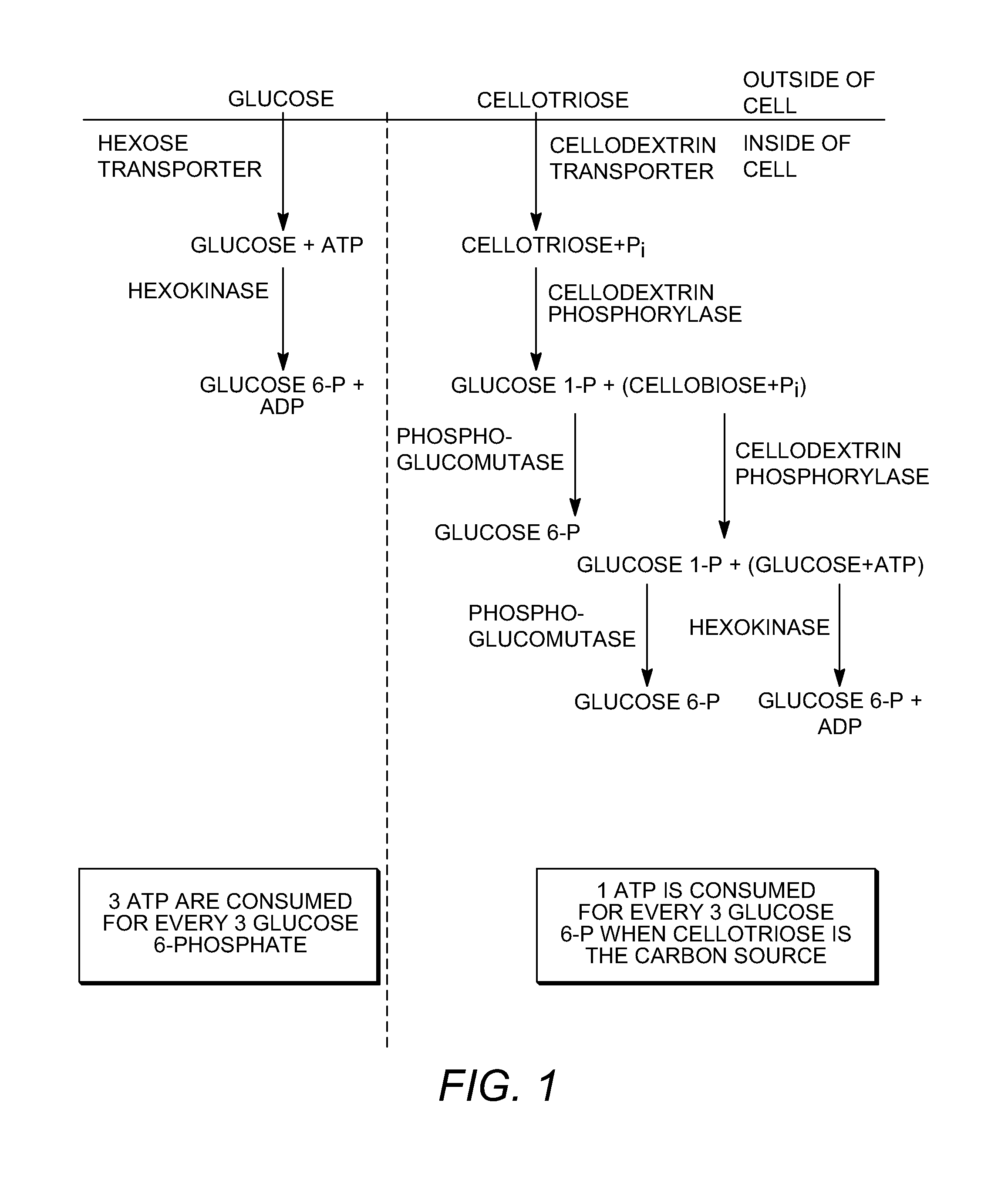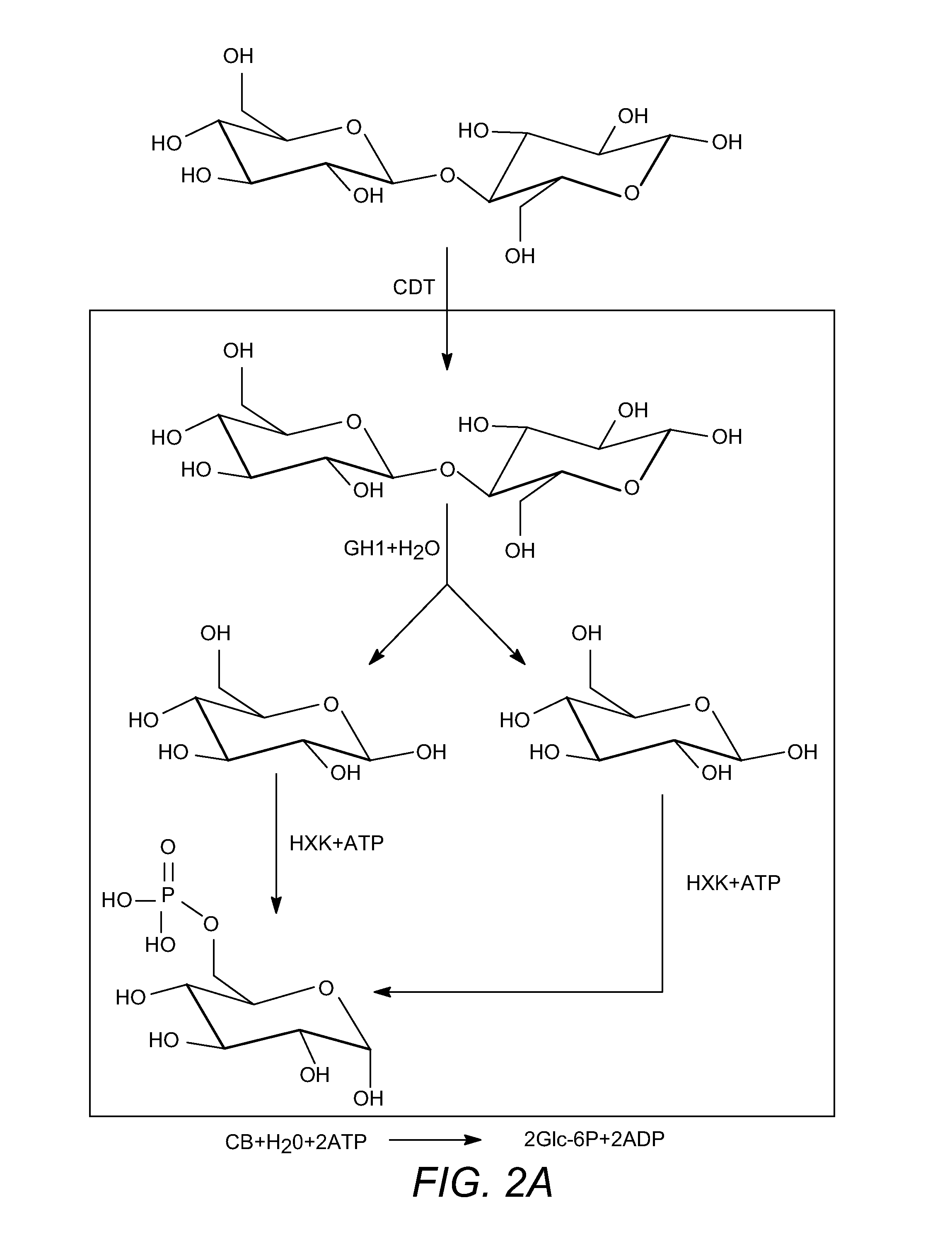Enhanced cellodextrin metabolism
a cellodextrin and metabolism technology, applied in the field of degrading cellodextrin, can solve the problem that engineered strains may not ferment glucose with optimal metabolism, and achieve the effect of reducing atp consumption
- Summary
- Abstract
- Description
- Claims
- Application Information
AI Technical Summary
Benefits of technology
Problems solved by technology
Method used
Image
Examples
example 1
Introduction
[0259]There is considerable interest in engineering microbes to convert the sugars found in plant cell walls to fuels and other chemicals. Plant cell walls are composed of cellulose (a polymer of glucose), hemicellulose (a heterogeneous polymer of pentoses, hexoses and sugar acids), and lignin (a heterogeneous phenolic polymer). They are abundant in agricultural and municipal wastes, and in dedicated energy crops. The yeast, Saccharomyces cerevisiae, is a favored platform for these engineering efforts because it is robust, simple to manipulate genetically, and capable of high carbon fluxes. Despite this, S. cerevisiae has a number of deficiencies including an inability to naturally ferment pentose sugars, sensitivity to solvents, and sensitivity to inhibitory compounds found in deconstructed plant material.
[0260]Another deficiency is that S. cerevisiae does not naturally ferment cellodextrins such as cellobiose. Cellodextrins are short polymers of β (1→4) linked glucose,...
example 2
[0336]This Example describes the identification of conserved motifs in cellodextrin phosphorylases and the identification of additional cellodextrin phosphorylases.
[0337]A first round of PSI-BLAST was run using the Clostridium thermocellum (BAA22081.1), Acidovibrio cellulolyticus (ZP—07328763.1) and Clostridium lentocellum (YP—004310865.1) cellodextrin phosphorylase amino acid sequences as simultaneous inputs. From the result of the first round, all hits annotated as “cellodextrin phosphorylase” were used as simultaneous inputs for a second round of PSI-BLAST.
[0338]From the results of the second round, all sequences annotated as “cellodextrin phosphorylase” were used to produce a multiple sequence alignment using T-COFFEE.
[0339]This multiple sequence alignment was used as an input for the PRATT server (http: / / web.expasy.org / pratt / ) to identify the highest scoring motif. The motif is shown in PROSITE format: G-x(2)-[FY]-x-N-[AGS]-x-[AS]-W-[APS]-V-[IL]-[AS]-x(2)-A-x(2)-[DE]-x-[AI]-x(3...
example 3
[0341]This Example describes the identification of conserved motifs in cellobiose phosphorylases and the identification of additional cellobiose phosphorylases.
[0342]Conserved Motif in Cellobiose Phosphorylase
[0343]A first round of PSI-BLAST was run using the Saccharophagus degradans (YP—526792.1), Cellvibrio gilvus (2CQS_A) and Clostridium thermocellum (YP—001036707.1) cellobiose phosphorylase amino acid sequences as simultaneous inputs. From the result of the first round, all hits annotated as “cellobiose phosphorylase” or “cellulose degradation product phosphorylase” were used as simultaneous inputs for a second round of PSI-BLAST.
[0344]From the results of the second round, all sequences that score higher than Saccharophagus degradans (YP—526792.1), Cellvibrio gilvus (2CQS_A) and Clostridium thermocellum (YP—001036707.1) cellobiose phosphorylases were used to produce a multiple sequence alignment using EXPRESSO with PDB file, 2CQS, as a structural template.
[0345]This multiple seq...
PUM
| Property | Measurement | Unit |
|---|---|---|
| Fraction | aaaaa | aaaaa |
| Fraction | aaaaa | aaaaa |
| Fraction | aaaaa | aaaaa |
Abstract
Description
Claims
Application Information
 Login to View More
Login to View More - R&D
- Intellectual Property
- Life Sciences
- Materials
- Tech Scout
- Unparalleled Data Quality
- Higher Quality Content
- 60% Fewer Hallucinations
Browse by: Latest US Patents, China's latest patents, Technical Efficacy Thesaurus, Application Domain, Technology Topic, Popular Technical Reports.
© 2025 PatSnap. All rights reserved.Legal|Privacy policy|Modern Slavery Act Transparency Statement|Sitemap|About US| Contact US: help@patsnap.com



